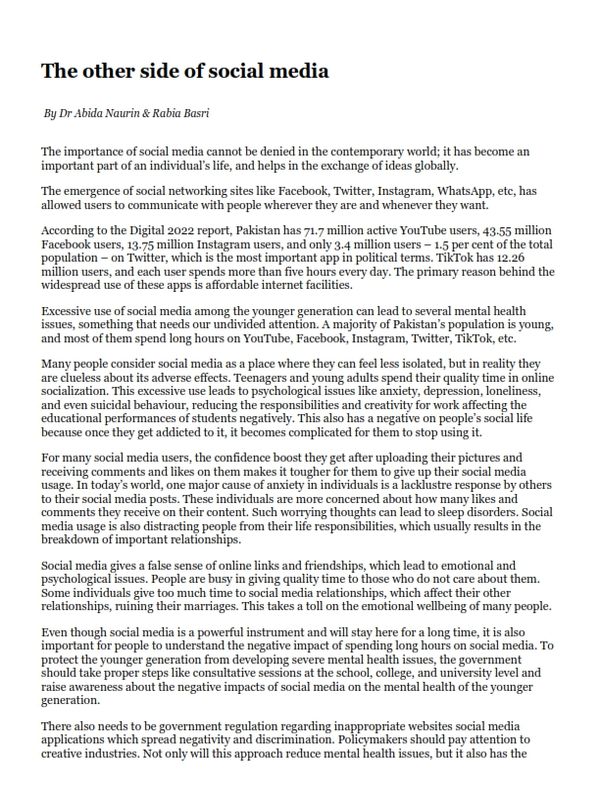
Pakistan Institute of Development Economics
- Home
Our Portals
MenuMenuMenuMenuMenuMenuMenu - ResearchMenuMenuMenuMenuMenuMenuMenu
- Discourse
- The PDR
- Our Researchers
- Academics
- Degree Verification
- Thesis Portal
- Our Portals
The Other Side Of Social Media
The importance of social media cannot be denied in the contemporary world; it has become an important part of an individual’s life, and helps in the exchange of ideas globally.
The emergence of social networking sites like Facebook, Twitter, Instagram, WhatsApp, etc, has allowed users to communicate with people wherever they are and whenever they want.
According to the Digital 2022 report, Pakistan has 71.7 million active YouTube users, 43.55 million Facebook users, 13.75 million Instagram users, and only 3.4 million users – 1.5 per cent of the total population – on Twitter, which is the most important app in political terms. TikTok has 12.26 million users, and each user spends more than five hours every day. The primary reason behind the widespread use of these apps is affordable internet facilities.
Excessive use of social media among the younger generation can lead to several mental health issues, something that needs our undivided attention. A majority of Pakistan’s population is young, and most of them spend long hours on YouTube, Facebook, Instagram, Twitter, TikTok, etc.
Many people consider social media as a place where they can feel less isolated, but in reality they are clueless about its adverse effects. Teenagers and young adults spend their quality time in online socialization. This excessive use leads to psychological issues like anxiety, depression, loneliness, and even suicidal behaviour, reducing the responsibilities and creativity for work affecting the educational performances of students negatively. This also has a negative on people’s social life because once they get addicted to it, it becomes complicated for them to stop using it.
For many social media users, the confidence boost they get after uploading their pictures and receiving comments and likes on them makes it tougher for them to give up their social media usage. In today’s world, one major cause of anxiety in individuals is a lacklustre response by others to their social media posts. These individuals are more concerned about how many likes and comments they receive on their content. Such worrying thoughts can lead to sleep disorders. Social media usage is also distracting people from their life responsibilities, which usually results in the breakdown of important relationships.
Social media gives a false sense of online links and friendships, which lead to emotional and psychological issues. People are busy in giving quality time to those who do not care about them. Some individuals give too much time to social media relationships, which affect their other relationships, ruining their marriages. This takes a toll on the emotional wellbeing of many people.
Even though social media is a powerful instrument and will stay here for a long time, it is also important for people to understand the negative impact of spending long hours on social media. To protect the younger generation from developing severe mental health issues, the government should take proper steps like consultative sessions at the school, college, and university level and raise awareness about the negative impacts of social media on the mental health of the younger generation.
There also needs to be government regulation regarding inappropriate websites social media applications which spread negativity and discrimination. Policymakers should pay attention to creative industries. Not only will this approach reduce mental health issues, but it also has the potential to contribute to the economy by creating opportunities for the youth in different fields (sports, arts, film industry, theatre).
Dr Abida Naurin is a research fellow at the Pakistan Institute of Development Economics (PIDE), Islamabad. She tweets @abida_15
Rabia Basri is an MPhil scholar at the economics and finance department at PIDE.



